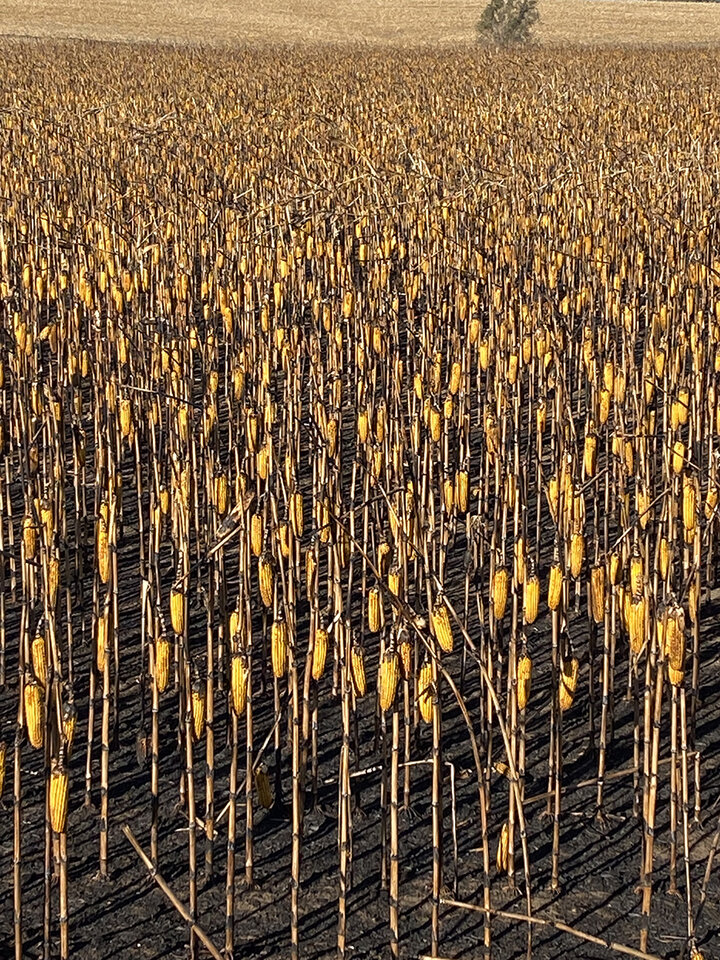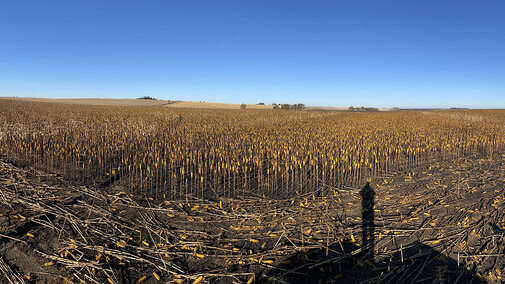Fires have been widespread in Nebraska this harvest season. We’ve received questions on what to do when both unharvested and harvested fields have been burned. Additional information on crop residue impacts from wildfire can be seen in this article, Fire Damage and Crop Residue Impacts, and range/pasture damage and stocking rates were shared in this article, FAQ for Wildfire Damage to Crops and Range/Pastureland. Make sure to contact your insurance company.
Q: What to do with unharvested corn?
A: Fire damage to unharvested fields can leave stalks remaining with a combination of ears attached to them and on the ground. One could take a sample of corn ears from across the pivot and send them in for feed analysis and also grain analysis. Ultimately, our recommendation is to harvest the corn like you normally would. Your local grain elevator may have insight into whether they would accept grain from an affected field and how this could affect quality or pricing.

Depending on grain analysis, one could take the grain to the elevator or mix with other grain in a ration for feeding. Cattle have been fed burnt corn grain before. The biggest concern would the loss in protein availability, depending on the extent of kernel damage. A fast fire may not have had enough time to burn through the starch and into the germ. That appears to be the case from the pictures we see. A measure of acid detergent insoluble crude protein would confirm how available crude protein is.
Q: What to do with corn ears on the ground? How to safely graze this?
A: One thought was to harvest what they could and disk the field. Then consider getting the ground covered with rye or wheat.
For those who would like to graze, Dr. Mary Drewnoski, beef systems specialist, shares the following recommendations:
Fire-damaged grain, if not completely destroyed, will have an appearance ranging from a slight brownish tint to black. This grain can be salvaged and fed to cattle. Common methods used by commercial labs for evaluation of energy content such as NIR analysis will not provide an accurate estimate of the energy availability from heat-damaged corn. However, color can be used as a crude indicator of the relative energy available for cattle. Based on research conducted at Iowa State, the amount of starch from brown and black corn that was digested in the rumen was about 30% less than normal corn. However, this corn would still have a significant amount of energy and can be used as an energy source.
The corn in burnt fields can be gleaned through grazing. However, cattle will need to be adapted to corn — similar to working cattle onto a finishing diet before turnout — or have limited access to avoid acidosis. Strip grazing is one method. Due to the fire removing the residue in the field, cattle will need to have a roughage source, such as hay, provided when grazing.
Grazing weaned calves on burnt corn fields could be a great way to use this feed resource. It is recommended to have them used to consuming at least 5 lbs of corn before turnout. In addition to a roughage source, these calves will need supplemental protein to make use of the best energy in the corn. Alfalfa hay could be used as a source of protein and roughage. Another option would be to provide free-choice grass hay plus 2 lbs of dried distillers.
Cull cows would be the next best option, as the corn can be used to put on extra weight and increase their value. Before turnout, producers should start feeding grain and work them up to at least seven to 10 lbs/hd of grain over a week to 10 days. If you don’t want to feed corn before turnout, then strip grazing can be used to adapt the cows to consuming corn. This Excel tool can be used to determine how much area to allocate.
Q: How will the fire impact my soil?
A: Please see the following article from Dr. Clain Jones from Montana State University on fire impacts to soil. The picture below of Table 2 from his article shows the N, P, K, and S in the top six inches of soil compared to nutrient removal in the grain or from stover that’s harvested or burned. In short, he shares that a small amount of nitrogen and sulfur are lost to the atmosphere, but increased nitrogen and other nutrients are made available due to quick mineralization from the fire. Additional nitrogen may be available next spring due to the combination of fire and drought conditions experienced. Microbes at the soil surface will be killed but will recolonize quickly deeper in the soil. We’d recommend taking a soil test including macro and micronutrients to determine nutrient availability. It may be wiser to do that next spring to see what’s available closer to the planting season as soil erosion from wind will most likely be a problem.

Ash may clog soil pores and wind erosion can cause a “sealing” of the soil surface, which reduces water infiltration from rain/irrigation. Drilling a small grain may help in disturbing the ash. Conducting a soil infiltration test may also be of benefit to know how one’s soil is impacted.
Q: How can soil be protected from erosion in burned fields?
A: We realize we’re in the middle of a drought. We still recommend trying to get winter small grains (winter wheat, triticale or cereal rye) planted as a cover crop in these fields. Rye will germinate at soil temperatures of 34°F, while winter wheat germinates at 39°F. Later than ideal, winter small grains can still be planted until the soil freezes, usually sometime in December. They likely won’t provide any cover this late fall and winter but will emerge in the spring to provide much-needed protection from erosion (wind and water).
Seeding depths of 1.0 to 2.0 inches and seeding rates of at least 50 pounds per acre are recommended. However, higher seeding rates (80-100 lbs/ac) could be warranted to provide quicker cover and biomass in the spring. Fungicide/insecticide seed treatments are usually not necessary when seeded as a cover crop.
If you haven’t seeded cover crops before or want to learn more, Nebraska Extension and the Midwest Cover Crop Council has “getting started on cover crop guidelines” after soybean and corn.
Spreading manure — especially manure with any bedding in it — can also be beneficial if one has availability to this at a large scale.
Resources
Berger, Aaron. 2017. Estimating Ears of Corn on the Ground by Counting Ears Prior to Grazing Corn with Cattle. https://beef.unl.edu/estimating-bushels-corn-ground-counting-ears-prior-grazing-cattle
Dahlke, Garland and Mary Drewnoski. 2011. The Feeding Value of Heat Damaged Corn Grain in Cattle Diets. https://dr.lib.iastate.edu/server/api/core/bitstreams/5f57ebb6-5d4e-4d18-8824-4e5eab1ca2a6/content
Debano, Leonard F. The Effect of Fire on Soil Properties. https://forest.moscowfsl.wsu.edu/smp/solo/documents/GTRs/INT_280/DeBano_INT-280.php
Drewnoski, Mary. 2017. Downed Corn: Problem or Opportunity for Cattle Producers. https://beef.unl.edu/down-corn-problem-or-opportunity-cattle-producers
Jones, Clain. 2017. Soil Scoop: Fire and Drought Effects on Soil Nutrients. https://landresources.montana.edu/soilfertility/documents/PDF/sscoop/FireDroughtSS.pdf

